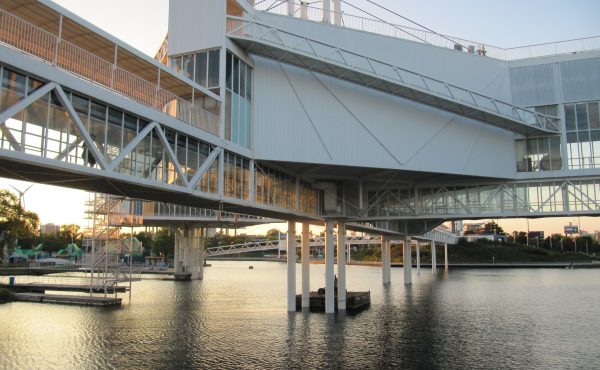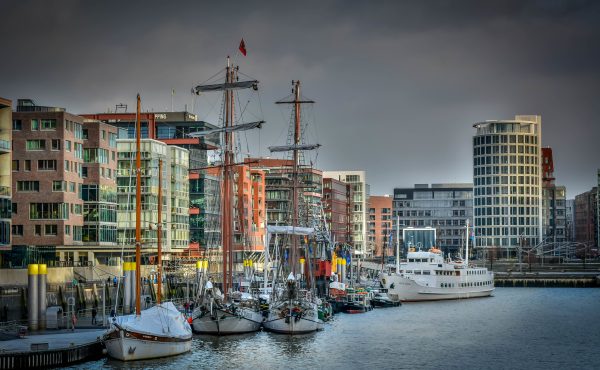
A view from what will one day be called Lake Ontario Park.
Thursday night, I went to the Port Lands Action Committee meeting to learn more about the soccer fields to be built just north of Cherry Beach —- the ones that more than 3000 people have signed a petition against.
Here’s what I learned:
There are still plans to build permanent soccer fields in a different area of the Port Lands (to be called Commissioners Park), but that won’t happen for some time due to the need to wait until the leases of private land owners expire and until the mouth of the Don River is reconstructed. In the meantime, the City and the TWRC want to build two synthetic-turf fields on a chunk of land south of Unwin Avenue. (Click here for a map of the area.)
Since this piece of land is owned by the City, construction of the new fields can start almost immediately. The TWRC argues that the trees and shrubs there have to come down anyway because the soil is highly contaminated with lead (10 times above acceptable standards). They’ve decided that the best way to deal with the contamination is to cap it, which involves covering it over so it isn’t exposed. The soccer fields will be built on top of the capped surface. When one resident asked how much it would cost to clean the soil (instead of capping it) TWRC rep Karen Pitre said, “A lot. I don’t know.†It appears that’s one option they haven’t considered.
The soccer fields will include a drainage system — storm water will flow to a nearby filtration pond, while run off from the new parking lot will be directed to a bioswale (a heavily planted ditch, which allows plants to uptake the storm water). The TWRC argues the parking lot is needed because the fields will be built before the new neighbourhood planned for the area is in place. Without reliable public transit, many people will need cars to get there.
At the meeting they said that the trees cut down will be replaced at a ratio of 2 to 1, contradicting a letter from Councillor Pantalone that stated four new trees would be planted for each tree that’s removed. A berm covered in trees will render the fields unnoticeable from the path along the beach, the landscape architect for the project said. There will be composting toilets, and lights on the fields so that games can go into the evening.
While the $5 million development will offer new places for people to play soccer in the short term, the fields won’t necessarily stay there permanently. “If at the end of ten years it’s decided that the fields don’t belong here, the City has said it will take the synthetic turf and use it elsewhere,†said Karen Pitre of the TWRC. A number of people in the crowd expressed concern that the fields wouldn’t mesh with plans for Lake Ontario Park, a naturalized area that will stretch from the eastern gap to Ashbridges Bay.
“What kind of commitment do we have to a natural forested greenway?†one resident wanted to know.
“We’ve been fighting to protect our ravines; the waterfront is just as important,†said another.
There were concerns that the high-powered lights would be detrimental to migratory birds and that the soccer pitches would be replacing what is now a feeding area for monarch butterflies.
Just as passionate, were the people who came to show their support for the new fields. “There is a desperate, desperate, desperate need for sports fields in the city,†said a director from the Toronto Sport and Social Club who is also a member of the Toronto Sports Council. “People always say [put soccer fields] somewhere else. I love the somewhere elses, but they are not happening,†he argued, echoing the sentiments of another man who said that the development of soccer pitches are threatened by NIMBYism in the same way that housing is. No one in the room seemed to know the last time a new soccer field was built downtown.
Soccer is one of Toronto’s fasted growing sports, yet, according to calculations, the City needs 89 to 90 (yep, that’s what they said!) more fields to meet current needs.
The councillor for the area, Paula Fletcher, expressed concern that the TWRC was taking a piecemeal approach: “I would feel far more comfortable if we were talking about this as part of Lake Ontario Park, because at the end of the day it will be part of it,†she said.
To provide some context, the TWRC website says the yet to be developed Lake Ontario Park demonstrates the coroporation’s commitment to a green, sustainable waterfront. “In the same way that Stanley Park has become synonymous with Vancouver, TWRC’s goal is to make Lake Ontario Park a defining destination for Toronto,†it says.
Fletcher argued that rushing ahead with the development of the soccer fields in this area is “like building a room before building a house.â€
In the end, it looks as though the TWRC will be developing the fields no matter what.
Photo from the TWRC website.




2 comments
I’d like to see someone find a way to build those fields over places like Greenwood subway yard or the open subway cuts between Bloor and Eglinton or over the railway alignments or the DVP. The fact that the TWRC was not able to present a cost-benefit analysis and costing for fully remediating the land in question here makes a joke of these public consultation sessions.
The reason for all the panic is not to build much needed soccer fields for Toronto’s kiddies, it’s for the FIFA under 20 tournament. If the city can’t deliver on a couple piddly little soccer pitches it would put an end to any aspirations to host the Olympics or other like circuses, so for that reason alone I hope this gets derailed.
There’s one of those urban myths at work in the analysis here though, the idea that Toronto needs more undeveloped greenspace parks, which is questionable, we have plenty of greenspace if you measure it per capita or as a percentage of city land in comparison to other large cities, what we lack is sufficient public recreation space, sports fields, recreation trails (and what we have like the Martin Goodman Trail, is in deplorable condition) and the like, so frankly on that basis I’m not convinced that this is such a bad project.